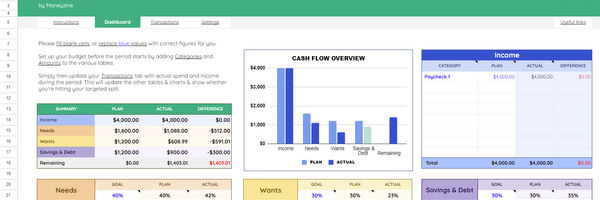Financial literacy is an essential skill enabling individuals to manage their money effectively and make sound financial decisions. However, as the financial literacy statistics below demonstrate, we could all use some more education.
To start learning right now, feel free to check out the insightful stats and facts presented below. Dive in and see just how much of an impact financial literacy skills—or the lack thereof—can have on our lives and why it is so important to start learning about personal finance as early as possible.
Key Findings
The percentage of US adults with poor financial literacy increased from 20% in 2017 to 25% in 2023.
Gen Z and Gen Y have the lowest financial literacy rates among US generations, at 38% and 45% correct answers, respectively.
There's a gender gap in financial literacy, with 62% of US adult males exhibiting financial literacy compared to 52% of females.
Financial literacy is correlated with income, as only 28% of Americans earning less than $25,000 per year are financially literate.
The lack of financial literacy cost Americans an estimated total of $388 billion in 2023.
Individuals with very low levels of financial literacy are seven times more likely to spend 20 hours or more per week dealing with personal finance-related issues.
Financial Literacy Among Different Demographics
Recent data indicates a troubling decline in overall adult financial literacy, with particular disparities among different demographics, genders, and income levels. This section delves into the nuances of these trends, revealing an upward trend in "very low" levels of financial literacy, significant knowledge gaps in crucial areas such as risk comprehension and investing, and stark differences in financial understanding across generations, genders, and socioeconomic statuses.
Despite a widespread desire among younger generations to enhance their financial knowledge, the journey toward improved financial literacy is hindered by educational gaps, socio-economic barriers, and a lack of real-world financial autonomy.
People have become less financially literate over the years
The percentage of US adults demonstrating a very low level of financial literacy increased from 20% in 2017 to 25% in 2023.
TIAA’s yearly released financial literacy index showed that the share of US adults exhibiting “very low” levels of financial literacy (ie, they correctly answered seven or fewer of the 28 index questions) has been on an upward trend in recent years.
Likewise, the share of questions answered correctly dropped from 52% in 2020 to 48% in 2023 – and is now lower than what it was in 2017 (49%).
What do they know and don’t know about finance?
At a success rate of 58%, Americans are most knowledgeable about debt and borrowing.
This is followed by saving at 55% and consuming at 50%.
At the other end of the spectrum, US adults scored considerably low on questions regarding risk comprehension – answering only 35% of the questions correctly.
This is followed by insuring at 42% and investing at 44%.
This is particularly alarming as comprehension of risk forms the basis of the majority of financial decisions.
Financial Literacy begins low in adulthood and improves only marginally with age
Gen Zers are the least financially literate generation.
In 2023, financial literacy across US generations was generally low, notably lowest in Gen Z and Gen Y, with only 38% and 45% correct answers on the P-Fin Index, respectively.
This contrasts slightly better scores in older generations: Gen X at 50%, Baby Boomers at 52%, and the Silent Generation at 53%. Additionally, a significant portion of younger generations struggled more, with 37% of Gen Z and 30% of Gen Y answering 25% or fewer questions correctly, compared to just 18% of Baby Boomers.
But they are definitely self-aware: 74% of teens in the US don’t feel confident in their personal finance knowledge.
That said, the good news is just as many, or 73% of US teens, would like to learn more about it.
Financial literacy facts for teens reveal that, although 62% of them say they learned about saving, 50% learned about earning, 44% learned about banking, and 42% learned about budgets, only 23% of US teens say they know how to make a budget.
The largest portion of teens, or 75%, learn about personal finance from their family, while only 52% learn about it at school. Interestingly, almost as many, 48%, say they learn about personal finance on social media, which may be why so many US teens are open to more personal finance education.
Knowledge is there, but there’s still a long way to go: Gen Z had the most regular financial conversations within the family.
In families, discussions about money varied by generation, with 73% of Millennials, 57% of Gen X, and 55% of Gen Z reporting regular financial conversations, compared to only 41% of Baby Boomers.
Younger generations, especially Gen Z (48%) and Millennials (42%), were more likely to discuss finances a few times a week, whereas Baby Boomers often did so a few times per month (32%).
Older generations were less likely to have positive experiences from these discussions, finding them more stressful than educational or encouraging, unlike the more positive reception among younger respondents.
The ambition to learn and improve has yet to translate into reality.
Pew Research reports that 34% of young adults received financial support from their parents in the past year, showcasing a disconnect between financial literacy aspirations and real-world financial autonomy.
Men tend to fare better than women
62% of US adult males exhibit financial literacy.
Statistics on financial literacy among the US adult population suggest that men are more likely to be financially literate than women. While 62% of adult males in the US exhibit financial literacy, the percentage of adult females who are financially literate is 52%.
This disparity between American men and women is consistent with financial literacy between the genders worldwide. However, the 10% gap present among US adults is double the global average, where the gap is much tighter, at 5%.
The knowledge discrepancy is the highest in investing.
The discrepancy between genders is reflected in every aspect of personal finance, ranging from 3% to 15% in difference.
Investing is where the literacy gap among genders is the largest at 15%, whereas both genders exhibit similar levels of knowledge regarding consuming.
This gap is not just a reflection of access to education but also of the broader socio-economic factors that limit women's exposure to financial learning and decision-making opportunities.
Higher-income Americans are significantly more financially knowledgeable than lower-income households
Only 28% of Americans with an income of less than $25,000 per year are financially literate.
There is a clear correlation between income levels and financial literacy, and the percentage of financially literate Americans increases alongside the income brackets.
Specifically, the next group on the financial literacy graph is Americans with a yearly income of between $25,000 and $49,000, and the percentage of them who are financially literate is already notably higher at 38%. The trend continues with 47% of US adults who earn between $50,000 and $99,000 and peaks at 58% for Americans who earn more than $100,000 per year.
14% of the variation in financial literacy performance among US students can be attributed to socioeconomic status.
Data on the financial literacy of 15-year-olds in the USA indicates that socioeconomically advantaged students tend to exhibit better financial literacy than disadvantaged students.
Namely, the level of financial literacy among students who grew up with socioeconomic advantages is notably better, allowing them to score an average score of 555 out of 1,000 on the latest program for international student assessment. Disadvantaged students, on the other hand, had an average score of 457, or 98 points lower than advantaged students.
Similarly, financial literacy performance varies among students of different ethnicities, and 15-year-old Asians have the best average score of 554. White students have the second-best average score of 532, followed by mixed-race students, with 518, Hispanic students, with 475, and Black students, with 446.
The gender disparity among 15-year-olds is very narrow, with boys having the better average score with a 6-point difference.
The landscape further complicates when dissecting data across income levels and communities
Research indicates that individuals from lower-income backgrounds are less likely to have engaged in financial education, deepening the divide between economic classes.
Specifically, financial literacy rates in the Black community and among women are alarmingly low, highlighting persistent inequalities. For instance, only 25% of Black Americans report feeling very confident about their financial literacy, starkly lower than their counterparts in other demographics.
These figures not only underscore the varying levels of financial literacy across demographics but also underline the urgent need for comprehensive, tailored education strategies.
The high interest in financial literacy among younger generations, like Gen Z and Millennials, provides a promising foundation for cultivating a financially savvy future populace.
Yet, the evident gaps in knowledge, confidence, and resource access among lower-income groups and marginalized communities necessitate a multifaceted approach to financial education—one that is inclusive, accessible, and responsive to the unique challenges faced by these groups.
Financial Education in Schools
The inclusion of financial education in schools has seen a gradual evolution. Historically, financial literacy was seldom a focus in the educational system.
However, the last two decades have witnessed a shift towards recognizing financial literacy as essential.
This change is partly due to the increasing complexity of financial products and the recognition of the high costs associated with poor financial literacy.
The lack of financial education at school left people unprepared
88% of Americans say that they weren’t fully prepared to handle money in high school.
This figure might explain their low confidence in their financial literacy, as well as their stress over managing finances.
Namely, money management facts from a recent survey reveal that 32% of Americans often stress about money, and another 42% sometimes feel stressed.
Data also reveals that 80% of Americans believe they would be better off if they learned more about personal finance in high school, and 76% think they would feel less stressed out if they did.
Another 74% of Americans also believe that they would’ve made fewer money mistakes if they learned more about personal finance in high school.
63% of Americans believe personal finance education should be taught in school.
Statistics on why financial literacy should be taught at school reveal that almost two-thirds of Americans are all for more finance education in school. Another 77% also say that politicians need to push for it, and 67% even say they would vote for a candidate who will prioritize this issue.
Some of the main reasons why Americans would like more personal finance education in schools become evident simply by looking at other facts about financial literacy. More than two in every five, or 41%, of Americans say they had to learn about personal finance by themselves. Another one in every three, or 33%, feel like their lack of financial knowledge keeps them from making financial progress.
There’s a strong advocacy of personal finance being taught in schools – and it’s paying off.
A survey conducted by the National Financial Educators Council revealed a substantial agreement among Americans on the importance of teaching financial literacy in schools, with 83.3% of respondents advocating for personal finance courses in high school.
As of 2023, there has been a notable increase in the number of states requiring high school students to take a personal finance course for graduation. According to Next Gen Personal Finance (NGPF), 25 states now require a course in personal finance to graduate, with recent additions including Minnesota, Indiana, and West Virginia.
Perception vs. Reality
Below, we highlight the stark contrast between Americans' perceived financial literacy and their actual understanding, revealing significant disparities across demographics, education levels, and generations.
Despite varying degrees of confidence, from Gen X's relative optimism to Gen Z's cautious self-assessment, the reality shows a nationwide struggle with financial concepts, particularly among younger generations and those with less formal education.
This gap underscores an urgent call for comprehensive financial education to bridge the divide between confidence and competence, ensuring all Americans are equipped for financial decision-making.
Americans' Perception of Their Financial Literacy
Self-Assessed Literacy:
60% believe they are somewhat financially literate.
29% consider themselves very financially literate.
Only 10% think they are not financially literate at all. By Demographic:
Gen Xers are the most confident, rating themselves at 6.3 out of 10.
Baby Boomers and Millennials are close behind, each with an average rating of 6.1.
Gen Zers are the least confident, with an average rating of 5.4 out of 10.
8% of men and 11% of women consider themselves financially illiterate.
32% of men and 23% of women view themselves as very financially literate.
Impact of Education:
Americans with a college degree rate their financial literacy higher, at 6.7 out of 10.
Those without a degree rate themselves at 5.7 out of 10.
The Reality of Financial Literacy Among Americans
Overall Financial Literacy:
The average financial literacy rate among U.S. adults is relatively low at a 48% correct response rate.
By Demographic:
Gen Z: Exhibits the lowest rates of financial literacy, with two-thirds able to answer only 50% or less of the index questions correctly.
Millennials (Gen Y): Also show low financial literacy, following Gen Z.
Men have a slightly higher average correct response rate (53%) compared to women (43%).
Educational Impact on Financial Literacy (P-Fin Index):
Less than high school degree: 29% correct answers.
High school degree: 37% correct answers.
College degree: 62% correct answers.
Key Takeaways
There is a significant gap between how Americans perceive their financial literacy and the reality, particularly among younger generations and those with lower education levels.
Confidence vs. Competence:
Certain demographics, especially Gen X and college graduates, exhibit high confidence in their financial literacy, which may not fully align with actual literacy levels as indicated by nationwide tests.
Generation Gap:
Younger generations, particularly Gen Z, are less confident in their financial literacy, a perception that aligns with their lower actual literacy rates.
The data underscores the need for enhanced financial education across all age groups and education levels to improve financial literacy and preparedness.
This comparison illustrates a clear discrepancy between perceived and actual financial literacy, indicating a pressing need for improved financial education and awareness programs.
The Cost of Financial Illiteracy
Financial illiteracy in the United States carries a significant cost, not only to individuals but also to the economy as a whole. Recent studies and surveys have illuminated the tangible impact of lacking financial knowledge, underscoring the urgency for improved financial education across the nation.
The average amount lost due to financial illiteracy went down in 2023, but there’s still a long way to go
According to a report by the National Financial Educators Council, the lack of financial literacy cost Americans an estimated total of $388 billion in 2023.
This staggering figure reflects the cumulative effect of poor financial decisions, including inadequate savings for retirement, excessive borrowing, and the costs associated with late payments and other financial missteps.
Since 2017, the NFEC has conducted annual surveys asking US adults how much money they believe they lost in the past year due to a lack of personal finance knowledge. Between 2017 and 2019, the average estimated loss increased by 4-5% annually.
However, in 2020, there was a significant spike to $1,634, nearly a 28% increase, likely reflecting the financial strain caused by the COVID-19 pandemic. In 2021, the average estimated loss decreased to $1,389, aligning with previous annual increases.
The 2022 survey reported the highest average loss per person at $1,819, correlating with record-high inflation and other economic challenges, leading to an estimated total loss of over $436 billion for the approximate 254 million U.S. adults.
Costly Financial Mistakes and Personal Impact
The most common financial mistakes include overdraft fees, luxury spending, credit card interest and fees, identity theft, and vehicle-related expenses.
The Consumer Financial Protection Bureau (CFPB) estimates $17 billion annually in overdraft and non-sufficient funds fees by American consumers. Additionally, Americans pay $120 billion annually in credit card debt, including interest and fees.
Financial illiteracy not only affects individuals personally but also extends to their families, social networks, employers, communities, and the country.
Reports show a strong correlation between physical and mental health issues and poor financial health.
The impact of financial stress on employees’ productivity generates a loss of nearly half a trillion dollars annually.
The P-Fin Index, an annual measure of financial literacy among US adults, provides further insight into the consequences of financial illiteracy.
Individuals with a very high level of financial literacy, defined as correctly answering more than 75% of the P-Fin Index questions, generally enjoy greater financial well-being.
Conversely, those with a very low level of financial literacy, who correctly answer only up to 25% of the questions, face significantly greater financial challenges:
They are more than four times as likely to have difficulty making ends meet, indicating the struggle to cover basic expenses from month to month.
Their likelihood of being debt-constrained is nearly three times higher, reflecting difficulties in managing and paying off debts.
They are three times more likely to be financially fragile, meaning they are at a higher risk of failing to cope with unexpected financial shocks.
They are over four times as likely to lack emergency funds sufficient to cover one month of living expenses, exposing them to greater vulnerability in times of financial emergencies.
Remarkably, they are seven times more likely to spend 20 hours or more per week dealing with personal finance-related issues, indicating a significant emotional and temporal cost.
These statistics paint a clear picture of the high cost of financial illiteracy in the US. They not only highlight the individual and societal implications of poor financial knowledge but also underline the importance of financial education.
Improving financial literacy could lead to enhanced financial well-being, reduce economic disparities, and foster a more robust economy.
Strategies for Improvement
Improving financial literacy is critical for empowering individuals to make informed financial decisions, ensuring economic stability, and fostering a culture of fiscal responsibility.
Embrace Financial Education Continuously
Diversify Learning Sources: Beyond books and workshops, consider enrolling in online courses offered by universities or financial institutions. Websites like Coursera and Khan Academy offer courses on personal finance basics, investment strategies, and financial planning.
Stay Updated: Follow reputable financial news outlets and blogs to stay informed about economic trends and financial tools. This continuous learning approach can help adapt to changing financial landscapes.
Utilize Technology for Financial Management
Financial Apps: Explore a variety of financial apps such as Mint and YNAB, which offer unique features to help with budgeting, saving, and investing.
Online Financial Tools: Leverage online calculators for budgeting, retirement planning, and investment returns to make informed decisions about your financial future.
Try out the time-tested 50/30/20 budgeting method

Easily track your spending, see how much you have left, and discover which categories to cut back on. The colors and chart give you visual cues to manage your spending. Just order the 50/30/20 budget template for Google Sheets to start your budget now!

Enhance Savings Strategies
Automate Savings: Set up automatic transfers to your savings account to ensure consistent savings. Consider high-yield savings accounts or money market accounts for better interest rates.
Engage with Financial Communities
Join Financial Forums: Participate in online communities, such as Reddit’s r/personalfinance or financial independence forums, where you can learn from others’ experiences and share your own.
Local Workshops and Seminars: Many communities offer free or low-cost workshops on financial planning, investing, and retirement. These can provide valuable information and networking opportunities.
Practice Responsible Credit Management
Understand Credit: Educate yourself on how credit scores work and the impact of credit on your financial life. Websites like Credit Karma can offer insights into your credit score and how to improve it.
Use Credit Wisely: Aim to pay off credit card balances each month to avoid high interest rates. Consider using credit cards that offer rewards or cashback for purchases you were already planning to make.


.jpg)


